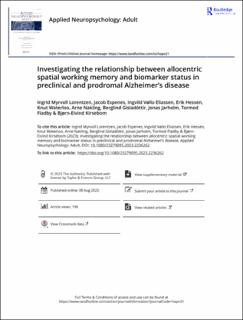| dc.contributor.author | Lorentzen, Ingrid Myrvoll | |
| dc.contributor.author | Espenes, Johan Jacob | |
| dc.contributor.author | Eliassen, Ingvild Vøllo | |
| dc.contributor.author | Hessen, Erik | |
| dc.contributor.author | Waterloo, Knut K | |
| dc.contributor.author | Nakling, Arne Exner | |
| dc.contributor.author | Gisladottir, Berglind | |
| dc.contributor.author | Jarholm, Jonas Alexander | |
| dc.contributor.author | Fladby, Tormod | |
| dc.contributor.author | Kirsebom, Bjørn-Eivind | |
| dc.date.accessioned | 2023-09-08T12:23:41Z | |
| dc.date.available | 2023-09-08T12:23:41Z | |
| dc.date.created | 2023-08-25T14:24:11Z | |
| dc.date.issued | 2023 | |
| dc.identifier.issn | 2327-9095 | |
| dc.identifier.uri | https://hdl.handle.net/11250/3088326 | |
| dc.description.abstract | The 4 Mountain Test (4MT) is a test of allocentric spatial working memory and has been proposed as an earlier marker of predementia Alzheimer’s disease (AD) than episodic verbal memory. We here compare the 4MT to the CERAD word list memory recall in both cognitively normal (CN) and mild cognitive impairment (MCI) cases with or without cerebrospinal fluid markers (CSF) of Alzheimer’s disease pathology. Linear regression was used to assess the influence of CSF determined Aβ-plaque (Aβ-/+) or neurofibrillary tau tangles (Tau-/+) on 4MT and CERAD recall performance. Analyses were performed in the full sample and the CN and MCI sub-samples. Pearson correlations were calculated to examine the relationship between 4MT and tests of psychomotor speed, verbal memory, cognitive flexibility, verbal fluency, and visuo-spatial perception. Analyses showed no significant differences in 4MT scores between Aβ-/Aβ+, nor Tau-/Tau + participants, irrespective of cognitive status. In contrast, CERAD recall scores were lower in both Aβ+ compared to Aβ- (p<.01), and Tau + compared to Tau- participants (p<.01) in the full sample analyses. There were no significant differences in CERAD recall performance between Aβ- vs. Aβ+ and Tau- vs. to Tau + in the in CN/MCI sub-samples. 4MT scores were significantly correlated with tests of psychomotor speed, cognitive flexibility, and visuo-spatial perception in the full sample analyses. In conclusion, the CERAD recall outperformed the 4MT as a cognitive marker of CSF determined AD pathology. This suggests that allocentric working memory, as measured by the 4MT, may not be used as an early marker of predementia AD. | en_US |
| dc.language.iso | eng | en_US |
| dc.publisher | Taylor & Francis | en_US |
| dc.rights | Navngivelse 4.0 Internasjonal | * |
| dc.rights.uri | http://creativecommons.org/licenses/by/4.0/deed.no | * |
| dc.title | Investigating the relationship between allocentric spatial working memory and biomarker status in preclinical and prodromal Alzheimer’s disease | en_US |
| dc.type | Journal article | en_US |
| dc.type | Peer reviewed | en_US |
| dc.description.version | publishedVersion | en_US |
| dc.rights.holder | Copyright 2023 The Author(s) | en_US |
| cristin.ispublished | true | |
| cristin.fulltext | original | |
| cristin.qualitycode | 1 | |
| dc.identifier.doi | 10.1080/23279095.2023.2236262 | |
| dc.identifier.cristin | 2169745 | |
| dc.source.journal | Applied neuropsychology: Adult | en_US |
| dc.identifier.citation | Applied neuropsychology: Adult. 2023. | en_US |

